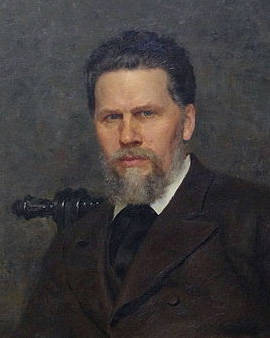Ivan Nikolaevich Kramskoy was born in the Russian city of Ostrogoschsk into an impoverished petty-bourgeois family. Despite this, the talented young man was able to study painting at the Saint Petersburg Academy of Art from the age of twenty to twenty-six. However, he soon began to rebel against the academic style of art and its restrictions, and even organized a kind of revolt called the "Revolt of the Fourteen," in which fourteen art students showed civil disobedience. This led to his eventual expulsion from the Academy. But Kramskoy did not give up fighting for his idea of artists' responsibility for their audience and for realism in art. Therefore, together with other painters, the artist founded the movement of Peredvishniki, in German Wanderer. The society existed for more than 50 years and organized traveling exhibitions in many Russian cities, for example in Moscow, Kiev, Kharkov, Kazan, Odessa and Riga. The painters of realism represented in it condemned the absolutist rule of Russia and wanted to show the complex sides of Russian society, especially the traditions of the people and urban and rural life. For them, naturalness and authenticity were very important and they no longer painted in the traditional dark colors of the time, but in bright, dazzling tones. Many very talented Russian painters, as well as artists from Ukraine, Armenia and Latvia joined the Peredvizhniki and Ivan Nikolaevich Kramskoy remained the head of the movement until his death in 1887.
The artist painted portraits of many important Russian scientists, writers and visual artists or other personalities of contemporary history. Among them are the writer Leo Tolstoy, the painter and graphic artist Iwan Schischkin, the merchant and patron of the arts Pavel Tretyakov, the Ukrainian national poet Taras Shevchenko, the writer Fyodor Dostoevsky, the philosopher Vladimir Soloviev, but also Tsar Alexander III. In addition, he also painted many pictures with biblical themes. He was a very religious man. One of his most famous paintings is called "Christ in the Desert". Many paintings by Kramskoy hang today in the Hermitage in Saint Petersburg and in the Tretyakov Gallery in Moscow. He was an artist who strongly influenced many Russian artists of his time with his special style and critical spirit.
×





.jpg)
.jpg)
.jpg)
.jpg)
.jpg)
.jpg)
.jpg)
.jpg)
_Le_Christ_assis_sur_un_rocher_l_-_(MeisterDrucke-1318554).jpg)
_Le_Christ_assis_sur_un_rocher_l_-_(MeisterDrucke-1318554).jpg)
.jpg)
.jpg)
.jpg)
.jpg)
.jpg)
.jpg)
 1863 - (MeisterDrucke-57431).jpg)
 1863 - (MeisterDrucke-57431).jpg)
.jpg)
.jpg)
.jpg)
.jpg)
.jpg)
.jpg)
.jpg)
.jpg)
.jpg)
.jpg)
.jpg)
.jpg)
.jpg)
.jpg)
.jpg)
.jpg)
.jpg)
.jpg)
.jpg)
.jpg)
_et_de_limperat_-_(MeisterDrucke-1406446).jpg)
_et_de_limperat_-_(MeisterDrucke-1406446).jpg)
.jpg)
.jpg)
 1886 - (MeisterDrucke-100618).jpg)
 1886 - (MeisterDrucke-100618).jpg)
 1873 - (MeisterDrucke-64057).jpg)
 1873 - (MeisterDrucke-64057).jpg)
_(Portrait_of_the_-_(MeisterDrucke-1322843).jpg)
_(Portrait_of_the_-_(MeisterDrucke-1322843).jpg)
.jpg)
.jpg)
.jpg)
.jpg)
.jpg)
.jpg)
 1871 - (MeisterDrucke-92613).jpg)
 1871 - (MeisterDrucke-92613).jpg)
_et_de_limperat_-_(MeisterDrucke-1398059).jpg)
_et_de_limperat_-_(MeisterDrucke-1398059).jpg)
_-_Peinture_de_Ivan_Nikolayevich_Kramskoi_(1837-1887)_huil_-_(MeisterDrucke-1314571).jpg)
_-_Peinture_de_Ivan_Nikolayevich_Kramskoi_(1837-1887)_huil_-_(MeisterDrucke-1314571).jpg)
 1878 - (MeisterDrucke-70827).jpg)
 1878 - (MeisterDrucke-70827).jpg)
.jpg)
.jpg)
.jpg)
.jpg)
_(Portrait_of_the_poet_YPolonsky)_Pe_-_(MeisterDrucke-1407218).jpg)
_(Portrait_of_the_poet_YPolonsky)_Pe_-_(MeisterDrucke-1407218).jpg)
.jpg)
.jpg)
_Peinture_de_Iva_-_(MeisterDrucke-1411211).jpg)
_Peinture_de_Iva_-_(MeisterDrucke-1411211).jpg)
_with_his_wife_Maria_Fedor_-_(MeisterDrucke-961094).jpg)
_with_his_wife_Maria_Fedor_-_(MeisterDrucke-961094).jpg)
.jpg)
.jpg)
_(vetue_dune_longue_robe_bla_-_(MeisterDrucke-1317967).jpg)
_(vetue_dune_longue_robe_bla_-_(MeisterDrucke-1317967).jpg)
.jpg)
.jpg)
 - (MeisterDrucke-195669).jpg)
 - (MeisterDrucke-195669).jpg)
 1873 - (MeisterDrucke-44089).jpg)
 1873 - (MeisterDrucke-44089).jpg)
.jpg)
.jpg)
.jpg)
.jpg)
.jpg)
.jpg)
_1876_-_(MeisterDrucke-560036).jpg)
_1876_-_(MeisterDrucke-560036).jpg)
.jpg)
.jpg)
.jpg)
.jpg)
_(1826-_-_(MeisterDrucke-1318344).jpg)
_(1826-_-_(MeisterDrucke-1318344).jpg)
_(Portrait_of_the_author_Gri_-_(MeisterDrucke-1408520).jpg)
_(Portrait_of_the_author_Gri_-_(MeisterDrucke-1408520).jpg)
.jpg)
.jpg)
.jpg)
.jpg)
.jpg)
.jpg)
.jpg)
.jpg)
.jpg)
.jpg)
.jpg)
.jpg)
.jpg)
.jpg)
_(Portrait_of_the_artist_-_(MeisterDrucke-1323035).jpg)
_(Portrait_of_the_artist_-_(MeisterDrucke-1323035).jpg)
.jpg)
.jpg)
_Prakhov_(1846-1916)_(Port_-_(MeisterDrucke-1313399).jpg)
_Prakhov_(1846-1916)_(Port_-_(MeisterDrucke-1313399).jpg)
.jpg)
.jpg)
.jpg)
.jpg)
.jpg)
.jpg)
_(Portrait_of_the_author_IGonch_-_(MeisterDrucke-1313449).jpg)
_(Portrait_of_the_author_IGonch_-_(MeisterDrucke-1313449).jpg)
.jpg)
.jpg)
 at the time of The Last Songs 1877 - (MeisterDrucke-104747).jpg)
 at the time of The Last Songs 1877 - (MeisterDrucke-104747).jpg)
.jpg)
.jpg)
.jpg)
.jpg)
.jpg)
.jpg)
.jpg)
.jpg)
_1879_-_(MeisterDrucke-572724).jpg)
_1879_-_(MeisterDrucke-572724).jpg)
_(Pompeii)_Vues_du_forum_des_ruines_romaines_dans_la_baie_de_Napl_-_(MeisterDrucke-939988).jpg)
_(Pompeii)_Vues_du_forum_des_ruines_romaines_dans_la_baie_de_Napl_-_(MeisterDrucke-939988).jpg)
.jpg)
.jpg)
.jpg)
.jpg)
.jpg)
.jpg)
_-_Pencil_brush_sepi_-_(MeisterDrucke-1376439).jpg)
_-_Pencil_brush_sepi_-_(MeisterDrucke-1376439).jpg)
 - (MeisterDrucke-661035).jpg)
 - (MeisterDrucke-661035).jpg)
.jpg)
.jpg)
 1871 - (MeisterDrucke-40132).jpg)
 1871 - (MeisterDrucke-40132).jpg)
.jpg)
.jpg)
.jpg)
.jpg)
 Fishing 1883 - (MeisterDrucke-119640).jpg)
 Fishing 1883 - (MeisterDrucke-119640).jpg)
.jpg)
.jpg)
_Femme_en_ro_-_(MeisterDrucke-1411432).jpg)
_Femme_en_ro_-_(MeisterDrucke-1411432).jpg)
.jpg)
.jpg)
.jpg)
.jpg)
 1876 - (MeisterDrucke-109101).jpg)
 1876 - (MeisterDrucke-109101).jpg)






